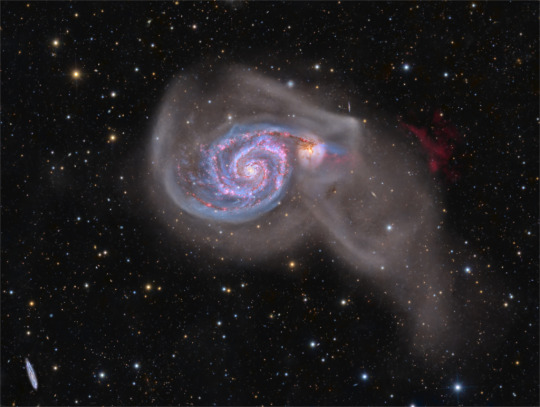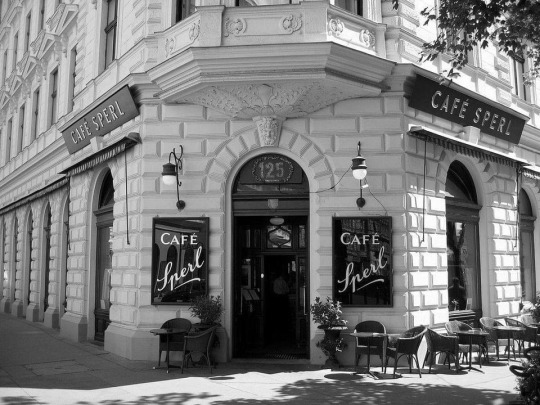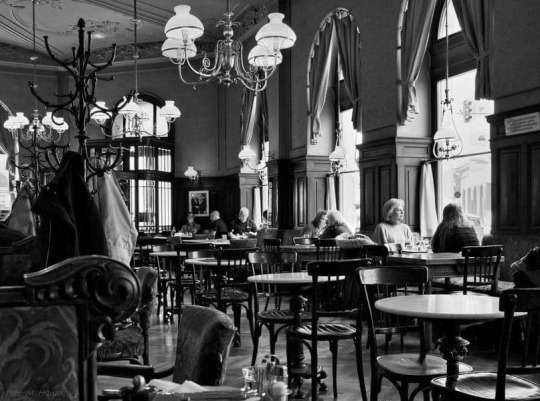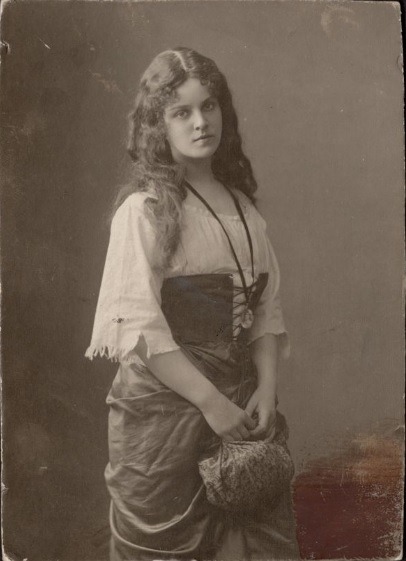#Richard Heuberger
Explore tagged Tumblr posts
Photo

2023 August 11
Messier 51 in 255 Hours Image Credit & Copyright: The Deep Sky Collective - Carl Björk, Thomas Bähnck, Sebastian Donoso, Jake Gentillon, Antoine and Dalia Grelin, Stephen Guberski, Richard Hall, Tino Heuberger, Jason Jacks, Paul Kent, Brian Meyers, William Ostling, Nicolas Puig, Tim Schaeffer, Felix Schöfbänker, Mikhail Vasilev
Explanation: An intriguing pair of interacting galaxies, M51 is the 51st entry in Charles Messier's famous catalog. Perhaps the original spiral nebula, the large galaxy with whirlpool-like spiral structure seen nearly face-on is also cataloged as NGC 5194. Its spiral arms and dust lanes sweep in front of a companion galaxy (right), NGC 5195. Some 31 million light-years distant, within the boundaries of the well-trained constellation Canes Venatici, M51 looks faint and fuzzy to the eye in direct telescopic views. But this remarkably deep image shows off stunning details of the galaxy pair's striking colors and extensive tidal debris. A collaboration of astro-imagers using telescopes on planet Earth combined over 10 days of exposure time to create this definitive galaxy portrait of M51. The image includes 118 hours of narrowband data that also reveals a vast glowing cloud of reddish ionized hydrogen gas discovered in the M51 system.
∞ Source: apod.nasa.gov/apod/ap230811.html
214 notes
·
View notes
Text
Old Vienna
Cafe Sperl…

Das Café Sperl ...

ist ein traditionsreiches, denkmalgeschütztes Wiener Kaffeehaus Ecke Gumpendorfer Straße und Lehargasse im 6. Wiener Gemeindebezirk Mariahilf.
1880 eröffnete Jacob Ronacher, Bruder von Anton Ronacher (dem Gründer des bekannten Etablissement Ronacher), ein Kaffeehaus unter dem Namen Café Ronacher im Eckgebäude Gumpendorfer Straße / Lehargasse. Die Ausgestaltung des Lokals im Stile eines Ringstraßen-Cafés mit Parkettboden, Stühlen von Thonet, Marmortischen, Kristallluster und Caramboltischen wurde von den Architekten Wilhelm Jelinek und Anton Groß ausgeführt. Noch im selben Jahr gab Ronacher jedoch das Geschäft auf und verkaufte es an die Familie Sperl, die es unter dem Namen Café Sperl weiterführte. 1884 wurde Adolf Kratochwilla Inhaber des Lokals, behielt aber den inzwischen etablierten Namen bei.
Zu den Stammgästen des Sperl zählten in der Zeit vor dem Ersten Weltkrieg eine kuriose Mischung aus Künstlern – Schriftstellern, Malern, Architekten, Komponisten, Musikern, Schauspielern – und Militärs der nahen k.u.k. Kriegsschule, zu letzteren zählten beispielsweise der spätere Chef des Generalstabs der österreichisch-ungarischen Armee Franz Conrad von Hötzendorf und Erzherzog Josef Ferdinand.
Von 1895 bis 1942 unterhielt der Künstlerbund Hagengesellschaft (aus dem 1900 der Hagenbund hervorgeht) hier seinen Stammtisch. Ebenfalls 1895 fand sich im Sperl der Siebenerclub, dem Josef Hoffmann, Leo Kleinradl, Adolf Karpellus, Maximilian Kurzweil, Koloman Moser, Joseph Maria Olbrich und Friedrich Pilz angehören, die später zusammen mit weiteren Künstlern die Wiener Secession ins Leben riefen. Darüber hinaus zählten in jener Zeit Joseph Lewinsky, Alexander Girardi, Edmund Eysler, Richard Heuberger, Karl Millöcker und Franz Lehár zu den Stammgästen des Sperl.
Nach dem Zweiten Weltkrieg nahm das Café seinen Betrieb wieder auf. 1968 übernahm Manfred Staub das Lokal von der Familie Kratochwilla und ließ es 1983 unter Erhaltung des denkmalgeschützten Ensembles renovieren. In den Folgejahren erlangte das Sperl verschiedene Auszeichnungen, so wurde es 1998 zum Österreichischen Kaffeehaus des Jahres ernannt und erhielt 2004 die Goldene Kaffeebohne. Zu den Stammgästen der jüngeren Vergangenheit zählten die Schriftsteller Jörg Mauthe, Robert Menasse und Michael Köhlmeier.
0 notes
Video
youtube
#music#violin#fritz kreisler#richard heuberger#itzhak perlman#der opernball#i'm obsessed with this album right now#it's absolutely brilliant
1 note
·
View note
Text
Happy birthday Richard Heuberger
0 notes
Text
Der Opernball – Opera Balosu Opereti Konusu (Richard Heuberger)
Der Opernball – Opera Balosu Opereti Konusu (Richard Heuberger)
Üç perdelik operet. Victor Léon ve Hugo von Waldberg.
1898 Viyana. Beaubuisson, Palmyra Beaubuisson, Henri, Paul Aubier, Angele Aubier, Georges Duménil, Marguérite Duménil,Hortense, Feodra. 1900 yıllarında Paris.
Paul Aubier eşiyle beraber Paris’e gelmiş, arkadaşı Duménil’in evine konuk olmuştur. Bu fırsattan yararlanıp çapkınlık etmek niyetindedir. İki arkadaş konu üzerinde konuşurlarken…
View On WordPress
0 notes
Link
The Johann Strauss Society of Great Britain — Composers — Richard Heuberger
0 notes
Photo

Italian mezzo-soprano Alice Barbi (1858-1949) with Brahms outside the Imperial Hotel in Vienna, 1892. Brahms wrote about her to Richard Heuberger: "From someone like Barbi we can all learn! Above all the Italian lady sings supremely steadily, with a solid pulse, and projects the structure of every piece she sings."
80 notes
·
View notes
Video
youtube
A sabiendas de ser una fuerza histórica inevitable, Schönberg logró ser un clásico sin haber sido reconocido en vida como tal. Como afirma Charles Rosen: “En la actualidad ya no tenemos la obligación de persuadir a nadie de su importancia, y ni siquiera de valorar su obra; sin embargo, esta no puede entenderse sin tener en cuenta la resistencia que despertó.” La grandeza de Schönberg radica en haber intuido como lo hicieran Bach y Beethoven la esencia de la música y haber explorado su expresividad polifónica hasta los límites de lo audible. Exploración que inicia en esta ópera sin palabras, Noche transfigurada, y que obsesivamente conducirá hasta el opus 21, Pierrot Lunaire. Uno de los más eminentes críticos de la época, Richard Heuberger, pese a ciertas reticencias, reconocía la hondura de dicha exploración en un artículo publicado en Neue Freie Presse (24/03/1903). “Solo una naturaleza seria y profunda puede encontrar sonidos semejantes, solo un talento extraordinario puede lograr brillar de tal modo en caminos tan oscuros.” Extraordinario estallido de creatividad que tras un periodo de gran silencio cristalizaría en la aritmética de los doce tonos. Inalcanzable búsqueda de la que ya este primer testimonio da cuenta. Inicio de la ascensión expresionista, que él mismo quebraría, abocado como estaba al extremo. “Sin duda las obras de arte importantes son en general las que aspiran a un extremo; las que se destruyen en el intento y cuyas líneas quebradas quedan como cifras de la innombrable verdad suprema.” (Adorno)
Pedro A. Cantero
2 notes
·
View notes
Text
The Brewers Association announces this year's 2019 Research Grants recipients including Oregon State University's Pat Hayes.
Press Release
Boulder, Colo. … The Brewers Association (BA)—the not-for-profit trade association dedicated to small and independent American brewers—today announced the recipients of its 2019 Research and Service Grants Program, designed to further the development of a healthy and sustainable raw materials supply chain. This year, 17 grants totaling $509,058 were awarded to researchers and organizations across the country.
“Ensuring a healthy supply chain is critical for our members,” said Bob Pease, president & CEO, Brewers Association. “As the agricultural landscape weathers a number of challenges, the Brewers Association is proud to fund grants that will enhance beer production and enable a more sustainable future.” The BA has provided more than $1.7 million in funding for 77 projects since the inception of the grant program in 2015. Funding has supported research and service grants addressing public barley and hop variety development, hop disease and hop aroma, as well as supporting affiliated national and state-level grower organizations. “We are grateful to the Brewers Association for the grant ‘Stable and Sustainable Dryland Production of High Quality Malt Barley’ to Montana State University,” said Dr. Jamie Sherman, assistant professor, Plant Sciences and Plant Pathology, Montana State University. “The support of the Brewers Association will enable the creation of barley lines with high malt quality under dryland conditions. Ultimately, the grant will increase sustainable production of barley by reducing water use. Dryland production is important to the long-term security of the barley supply chain particularly for Montana where 80 percent of available acres are dryland.”
2019 Grant Recipients (please see complete summary here: PDF)
Barley
Building a Winter Malting Barley Market for the Great Plains
Partner(s): University of Nebraska-Lincoln
Principal: Stephen Baenziger
Characterization of Genotype by Environment Interaction for Malting Quality in New York State
Partner(s): Cornell University Department of Plant Breeding and Genetics
Principal: Mark Sorrells
Stable and Sustainable Dryland Production of High-Quality Malt Barley
Partner(s): Montant State University
Principal: Jamie Sherman
Interaction Between Barley Genetics and Malt Process Impact on Flavor
Partner(s): Montana State University
Principal: Hannah Turner
Winter and Spring 2-Row Malt for Conventional and Organic Systems
Partner(s): Montana State University
Principal: Jed Eberly
Improving Malting Quality in Two-Rowed Barley by Reducing Grain Protein and β-Glucan Content Through Marker Assisted Backcrossing
Partner(s): University of California, Davis
Principal: Alicia del Blanco
Development of Two and Six-Rowed Winter Malt Barley Varieties for the Eastern U.S.
Partner(s): Virginia Polytechnic Institute and State University
Principal: Carl Griffey
Evaluating a Multi-State Breeding Project to Produce Local Malting Barley for the Craft Brewing Industry
Partner(s): University of Minnesota
Principal: Kevin Smith
The Continuing Quest for Flavor: From the Oregon Promise to the Romp of Otters
Partner(s): Oregon State University
Principal: Pat Hayes
Enhancement of Winter Hardiness in Two-Rowed Barley Germplasm for the Craft Brewing Industry
Partner(s): University of Minnesota
Principal: Brain Steffenson
Identifying Spring Malting Barley Varieties for the Craft Brewing Industries
Partner(s): North Dakota State University
Principal: Richard Horsley
Effects of Variety by Malting Interactions on the Malt and Beer Metabolome
Partner(s): Colorado State University
Principal: Adam Heuberger
Metabolomics and Genomics Analysis of the ‘Romp of Otters’ Barley Flavor Project
Partner(s): Colorado State University
Principal: Adam Heuberger
Hops
Multifaceted Impacts of Nitrogen and Sulfur Fertility on Hop Productivity, Quality, and Brewing Characteristics
Partner(s): US Department of Agriculture; Oregon State University
Researcher: David Gent
Mapping Novel Loci for Powdery Mildew Resistance in Hops
Partner(s): University of Minnesota
Principal: Gary Muehlbauer
Development and Application of Cost-Effective DNA-Based Markers for Hops
Partner(s): USDA-ARS National Clonal Germplasm Repository
Principal: Nahla V. Bassil
Development of Thiols and Thiol Precursors in Different Hop Varieties During Hop Harvest and their Impact on Beer Flavour
Partner(s): Nyseos, Barth-Haas Group
Researcher: Laurent Dagan, Christina Schoenberger
Proposals for 2020 calendar year funding will be accepted from March 1, 2019 until May 31, 2019 and can be submitted on the Brewers Association website.
###
About the Brewers Association The Brewers Association (BA) is the not-for-profit trade association dedicated to small and independent American brewers, their beers and the community of brewing enthusiasts. The BA represents more than 4,800 U.S. breweries. The BA’s independent craft brewer seal is a widely adopted symbol that differentiates beers by small and independent craft brewers. The BA organizes events including the World Beer Cup®, Great American Beer Festival®, Craft Brewers Conference® & BrewExpo America®, SAVORTM: An American Craft Beer & Food Experience, Homebrew ConTM, National Homebrew Competition and American Craft Beer Week®. The BA publishes The New Brewer® magazine, and Brewers Publications® is the leading publisher of brewing literature in the U.S. Beer lovers are invited to learn more about the dynamic world of craft beer at CraftBeer.com® and about homebrewing via the BA’s American Homebrewers Association® and the free Brew Guru® mobile app. Follow us on Facebook, Twitter and Instagram.
The Brewers Association is an equal opportunity employer and does not discriminate on the basis of race, color, national origin, gender, religion, age, disability, political beliefs, sexual orientation, or marital/familial status. The BA complies with provisions of Executive Order 11246 and the rules, regulations, and relevant orders of the Secretary of Labor.
from News - The Northwest Beer Guide http://bit.ly/2AL75xv
0 notes
Text
June 18 in Music History
1466 Birth of early music printer Ottaviano de Petrucci in Italy.
1677 Birth of Italian opera composer Antonio Maria Bononcini in Modena.
1723 Birth of composer Giuseppe Scarlotti.
1726 Death of French composer Michel-Richard de Lalande in Versailles.
1744 Birth of composer Augustin Holler.
1757 Birth of Austrian piano manufacturer and composer Ignaz Joseph Pleyel.
1780 Birth of composer Michael Henkel.
1799 Death of Mozart's German music publisher Johann André in Offenbach.
1803 FP of Méhul/Boieldieu/Kreutzer/Nicolo: "Le Baiser et la quittance, ou Une Aventure de garnison" Paris.
1807 FP of Gyrowetz's "Die Junggesellen-Wirtschaft" Vienna.
1816 FP of Boieldieu/Herold's "Charles de France" Paris.
1820 Birth of composer Martin Andreas Udbye.
1821 FP of C. M. Von Weber's opera Der Freischutz at the Königliches Schauspielhaus, in Berlin.
1822 Birth of composer Henry David Leslie.
1831 FP of Donizetti's "La Romanziera e l'uomo nero" Opera buffa, Naples.
1837 Felix Mendelssohn completes his String Quartet in e, Op. 44, no. 2, while on his honeymoon in Freiburg, Germany.
1848 Birth of Belgian baritone Jacques Bouhy.
1850 Birth of Austrian-German composer Richard Heuberger in Graz.
1872 Birth of English pianist Katharine Goodson.
1876 Birth of French soprano Marcelle Demougeot in Dijon.
1880 Birth of Mexican composer Jose Pomer in Mexico City.
1887 Birth of American soprano Blanche Yurka in St. Paul, MN.
1887 Birth of soprano Kamila Ungrova in Kourim.
1889 Birth of Italian tenor Ismaele Voltolini in Mantua.
1891 FP of Bruneau's "Le Rêve" Paris.
1892 Birth of German pianist Edward Steuermann.
1896 Birth of Australian composer and organist Sir George Thalben-Ball.
1903 Birth of American soprano Jeanette MacDonald.
1904 Birth of French composer and conductor Manuel Rosenthal in Paris.
1905 Birth of Estonian-Swedish composer Eduard Tubin in Kallaste.
1907 Alexander Glazunov receives Mus.D. degree from Oxford University.
1915 Birth of French composer Victor Legley in Hazebrouck.
1917 Birth of composer Akhmet Jevdet Ismail Hajiyev.
1923 Birth of American ethnic music composer Elizabeth Waldo.
1927 Birth of Hungarian tenor Robert Ilosfalvy in Hódmezoevasárhély.
1927 Birth of composer Simeon Pironkov.
1933 Birth of Australian composer Colin Brumby in Melbourne.
1934 Birth of composer Pavle Dešpalj.
1941 Birth of Dutch conductor Hans Vonk in Amsterdam.
1942 Birth of British singer and composer Sir Paul McCartney.
1943 Birth of Hungarian soprano Eva Marton.
1944 Birth of American computer composer Paul Lansky in NYC.
1945 Birth of English horn player and conductor Anthony Halstead.
1947 Birth of composer Douglas Young.
1948 Birth of Welch baritone Arwel Huw Morgan in Neath S. Wales.
1950 Birth of Polish-American composer Jan Radzynski in Warsaw, Poland.
1950 Birth of American composer Frank Ferko in Barberton, OH.
1952 Death of baritone Heinrich Schlushnus.
1953 Birth of English pianist Peter Donohoe.
1955 Death of Swiss composer Willy Burkhard in Zürich.
1955 FP of Pierre Boulez`cantata Le Marteau sans Maitre in Baden-Baden.
1957 Birth of American composer Rand Steiger in NYC.
1957 Death of tenor Georgi Nelepp.
1958 FP of B. Britten's opera Noye's Fludde at Orford Church, Aldeburgh.
1962 FP of Halffter's Oratio 1st stage perf., la Scala.
1962 Death of Swiss composer and conductor Volkmar Andreae in Zurich.
1962 FP of Manuel de Falla`s opera Atlantida in Milan.
1963 Death of Dutch tenor Hans Kaart.
1971 Death of baritone Heinrich Nillius.
1977 FP of Davies' "The Martyrdom of St. Magnus" chamber opera, Kirkwall.
1978 Death of Brazilian baritone Lourival Braga.
1980 FP of V. Persichetti's Three Toccatinas for Piano. Performed by contestants in the International Piano Festival and Competition at the University of Maryland, College Park, MD.
1982 FP in USAmerica, Stage Premier, Verdi: Il Corsaro in San Diego, CA.
1992 FP of Anthony Davis' opera Tania at the American Music Theater Festival in Philadelphia, PA.
1994 Death of soprano Rosemare Broncato.
1 note
·
View note
Audio
Max Greger and his Orchestra : “Gehen wir ins Chambre Séparée”
from Richard Heuberger´s Operetta “Ein Opernball)
(Strict Ballroom Tempo)
1 note
·
View note
Link
Alles gute zum geberstag Richard Heuberger
0 notes
Video
youtube
Rita Streich and Peter Anders sings "Gehen wir ins Chambre separée" from Der Opernball by Richard Heuberger Franz Marszalek and his orchestra 1954
0 notes
Photo

Minnie Nast (10 October 1874 – 20 June 1956) was a German soprano. She was born in Karlsruhe and studied at the Karlsruhe Conservatory, making her début at Aachen in 1897. She studied singing at the conservatory in Karlsruhe under Hermann Rosenberg and with Bianca Bianchi in Salzburg. She made her debut in 1897 at the Stadttheater in Aachen. In 1898 she joined to the Hofoper in Dresden. Here she appeared up to the end of her stage career (1919). On 26. 1. 1911 she sang at the Hofoper in Dresden in the premiere of R. Strauss’s "Der Rosenkavalier". She appeared in Dresden also in two other opera premieres of Richard Strauss: on 21. 11. 1901 in "Feuersnot", on 25. 1. 1909 in a small role in ‘’Elektra’’. The other premieres in which she appeared in Dresden were "Das war ich" by Leo Blech (6. 10. 1902), "Alpenkönig und Menschenfeind" by the same composer (1. 10. 1903), "Barfüßele" of Heuberger (1905), "Die Schneider von Schönau" by Jan Brandts-Buys (1. 4. 1916) and "Coeur As" by Eduard Künneke (1913). She created the title role in G. Puccini’s ‘’Madama Butterfly’’ for Dresden. She made guest appearances in Amsterdam (1902, 1910 as well as in 1917 as Sophie in "Rosenkavalier"), Berlin (1906), Munich, St. Petersburg, Vienna (1906, 1908) and Prague (1903). In 1905 she toured through the USA and Canada. Her stage repertoire included Cherubino in "Figaros Hochzeit", Pamina in "Zauberflöte", Marguerite in ‘’Faust’’, Mimi in ‘’La Bohème’’ and Eva in "Meistersingern". She was married to the Karl von Frenckell, who served as Finnish consul in Dresden. In 1919 she sang for the last time in Dresden in G. Puccini’s ‘’Boheme’’ and then worked as a pedagogue in Dresden.
0 notes
Video
youtube
Richard Heuberger Opernball Walzer Wiener Symphoniker unter Leitung von Robert Stolz.
0 notes
Photo

Alice Laura Barbi (1 June 1858 – 4 September 1948) was an Italian mezzo-soprano and violinist. She had a short, yet successful career as a concert performer. She was a close friend of Johannes Brahms. She began studying music at a young age under her father Henry's guidance. She was a near-prodigy violinist,[2] debuting at the age of seven. After staying in Egypt she studied in Bologna at the Conservatorio Giovanni Battista Martini. She was trained in musical theory and studied multiple languages. She attended lectures by Carlo Verardi. She later dedicated herself to singing, studying with Luigi Zamboni and Alessandro Busi in Bologna and later with Luigi Vannuccini in Florence. Barbi started her singing career alongside Antonio Cotogni and Giovanni Sgambati in a concert at the Quirinale. Her public debut was a concert organized by impresario Andreoli in Milan on 2 April 1882. The program included four arias from Handel, Haydn, Jommelli, and Rossini. Schumann and Schubert were her specialities for recitals. A review by William Beatty-Kingston in The Theatre praised the two chamber music recitals she gave at Prince's Hall in July 1886. He referred to her as the best cantatrice di camera in Europe and described her singing as "the outcome of a rare and surprising combination of natural gifts and indefatigable cultivation." Her program for the recitals illustrated the development of vocal music since the 17th century. Beatty-Kingston wrote that "All the laudatory adjectives in my vocabulary are insufficient to express my sense of the beauty, grace and poetical feeling characterising her rendering of these compositions, one and all." In addition to singing, she performed as a violinist on occasion. Barbi spent considerable time abroad, traveling to Austria, Germany, England, and Russia. Barbi found an ardent admirer in German composer Johannes Brahms and the pair were close friends in his final years. Brahms wrote to Austrian composer Richard Heuberger about Barbi toward the close of 1890, relating that "From someone like Barbi we can all learn! Above all the Italian lady sings supremely steadily, with a solid pulse, and... projects the structure of every piece she sings." Brahms arranged for Barbi to visit Clara Schumann that autumn. The first time he heard her sing one of his songs, he said, "Today I've heard my songs for the first time." Brahms would accompany Barbi around Venice. While their relationship was platonic, it was the subject of gossip and Brahms told Ignaz Brüll that she was the only woman he had wanted to marry after middle age.
0 notes